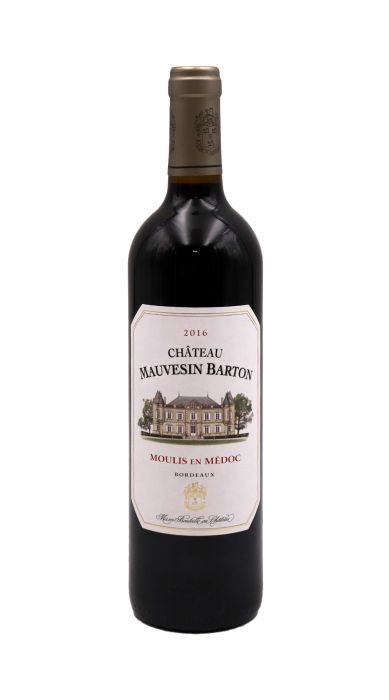Need Help Finding the right wine?
Your personal wine consultant will assist you with buying, managing your collection, investing in wine, entertaining and more.
NYC, Long Island and The Hamptons Receive Free Delivery on Orders $300+
Checkout using your account
Checkout as a new customer
Creating an account has many benefits:

2016 Chateau Mauvesin Barton
92 JS
James Suckling | 92 JS
| Type of Wine |
Bordeaux Red
: Picture in your mind a combination of cedar, lead pencil, blackcurrant, plum and mineral aromatics, and texture that caresses your palate like a playful lover. The experience is thrilling from the first whiff to the final seconds of a tannic, generous finish - that is what you'll get from a Bordeaux Red |
|---|---|
| Varietal |
Red Bordeaux Blend
: The inhabitants of the Bordeaux region of France have been cultivating wine-grapes for thousands of years. Ancient Roman ruins litter the vineyards from Saint Emilion to Graves where the art of blending Bordeaux varietals has been practiced and perfected over a very long history. Bordeaux’s climate, terroir and soils, though varied, provide the optimal growing conditions for the red grape varietals planted in the region. Rarely listed on the labels as “blend,” the red wines of Bordeaux are perhaps the most artfully designed and celebrated in the world. The calculated art of blending the native Bordeaux varietals is impressively accomplished in the most famous winegrowing region in the world. The phrase Bordeaux Blend which seems to have been coined by British wine merchants in the 19th Century relates as much to wines made from the blend as to the grape variety combination itself. Cabernet Sauvignon, Merlot, Cabernet Franc, Petit Verdot, Malbec and occasionally Carmenere are the lead characters in the creation of Red Bordeaux Blends. Each plays a part in their own fashion and implemented in various combinations and percentages in each appellation within Bordeaux. Red Bordeaux Blends are majorly composed of Cabernet Sauvignon and Merlot, roughly making up 90% of all Bordeaux Blends. Cabernet Franc, Petit Verdot and Malbec (occasionally Carmenere) are also important components and vital to the production of the region’s red wines. For simplicity, the winegrowing region of Bordeaux can be divided into three main appellations producing Red Bordeaux Blends; the Left Bank (Medoc), Right Bank and Pessac-Leognan (Graves). The Left Bank has a terroir comprised of a wide variety of gravel, stones, sand, limestone and clay soils on a natural terrain of gentle slopes. This sets the stage perfectly for the production of Cabernet Sauvignon, which is the dominant grape of the Left Bank. For example, Chateau Lafite (Paulliac) is composed of 70% Cabernet Sauvignon. The Right Bank is dominated by clay and limestone with sand and gravel, but the clay in the Right Bank is distinctly its own and adds to the health, growth and vitality of the vines of the varietals grown here. Right Bank wines are typically 80% Merlot-based, which are often denser, richer and mature earlier than those of the Left Bank (with exceptions – Petrus for example). Merlot is a vital component to Pomerol winegrowing and making. Cabernet Franc also plays a major role in the Right Bank, most notably, in Saint Emilion, where the infamous vineyards of Chateau Ausone and Chateau Cheval Blanc are planted to 55% and 52% Cabernet Franc, respectively. Chateaux that produce wines with a majority of Cabernet Franc are considered “old school” producers, but have perfected the use of Cabernet Franc, which was originally used as a blending grape. Pessac-Leognan (Graves) enjoys a temperate climate, natural hygrometry influenced by the ocean, and has a terroir composed of gravelly soil over a clay subsoil on sloping, hilly terrain. Natural drainage due to the hilly terrain as well as the gravelly soil structure are perfectly attuned to the Cabernet Sauvignon grape vine, which prospers under these conditions. Pessac reaps the benefits of having the terroir of both the Left and Right Bank as it contains gravel and clay. The clay sub-soil allows the growth and success of Merlot, as well as Cabernet Franc. It is home to the only First Growth not in the Medoc. The 50-hectare vineyard of Haut Brion is planted to 45.4% Merlot, 43.9% Cabernet Sauvignon, 9.7% Cabernet Franc and 1% Petit Verdot. The percentage of Petit Verdot and Malbec may be lesser in quantity, but not in quality. They are vital to the region’s creation of Red Bordeaux Blends. The combination of Bordeaux varietals is legendary in the region, around the world and has influenced winegrowers worldwide to plant and vinify wines which resemble those of Red Bordeaux Blends. |
| Country |
US
: As one of the most prolific and innovative wine regions in the world, America is a joy to explore. Most wine connoisseurs will agree that the nation's finest and most compelling wines are being produced today, which means that we have front-row seats to one of the most inspirational stories in wine history. While other regions tend to focus on specific wine styles and have somewhat strict rules as to which varietals you could grow, areas like California have few such restrictions in place. As a result, creative visionaries behind America's most reputable estates have been able to develop compelling, unique, and innovative styles, with a level of terroir expression that rivals even France's largest giants. |
| Subregion | Moulis-en-Medoc |
| Producer | Chateau Mauvesin Barton |
|---|
Need Help Finding the right wine?
Your personal wine consultant will assist you with buying, managing your collection, investing in wine, entertaining and more.